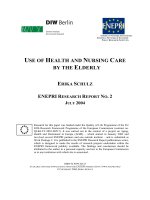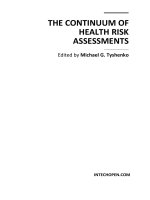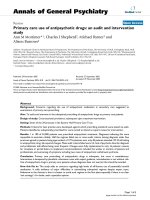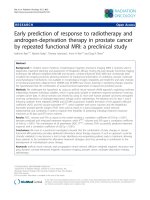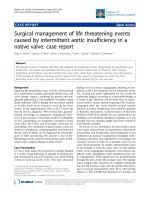BioPro-RCMI-1505 trial: Multicenter study evaluating the use of a biodegradable balloon for the treatment of intermediate risk prostate cancer by intensity modulated radiotherapy; study
Bạn đang xem bản rút gọn của tài liệu. Xem và tải ngay bản đầy đủ của tài liệu tại đây (553.24 KB, 6 trang )
Pasquier et al. BMC Cancer (2018) 18:566
/>
STUDY PROTOCOL
Open Access
BioPro-RCMI-1505 trial: multicenter study
evaluating the use of a biodegradable
balloon for the treatment of intermediate
risk prostate cancer by intensity modulated
radiotherapy; study protocol
David Pasquier1,2* , Emilie Bogart3, François Bonodeau4, Thomas Lacornerie5, Eric Lartigau1,2 and Igor Latorzeff6
Abstract
Background: Prospective trials have demonstrated the advantage of dose-escalated radiotherapy for the
biochemical and clinical control of intermediate risk prostate cancer. Dose escalation improves outcomes but
increases risks of urinary and bowel toxicity. Recently the contribution of “spacers” positioned in the septum
between the rectum and the prostate could improve the functional results of intensity modulated radiation therapy
(IMRT). To date most of the evaluated devices were polyethylen glycol (PEG) and hyaluronic acid (HA). Men on the
Spacer arm had decreased bowel toxicity and less decline in both urinary and bowel quality of life as compared to
Control men in a randomized trial.
Methods: This is an interventional, multi-center study to evaluate the use of biodegradable inflatable balloon for patients
with intermediate risk prostate cancer treated by IMRT (74 to 80 Gy, 2 Gy/fraction) with daily image guided radiotherapy.
Discussion: This multicenter prospective study will yield new data regarding dosimetric gain and implantation stages of
Bioprotect balloon. Acute and late toxicities and quality of life will be registered too.
Trial registration: NCT02478112, date of registration: 15/06/2015.
Keywords: Implantable biodegradable balloon, Rectal spacer, Intensity modulated radiotherapy, Prostate cancer
Background
Prospective trials have demonstrated the advantage of
dose-escalated radiotherapy for the biochemical and
clinical control of prostate cancer. This benefit observed
with three-dimensional conformational irradiation is
counterbalanced by an increase of the urinary and digestive toxicities [1–4]. The Medical Research Council
(MRC) conducted the MRC 01 randomized multicenter
trial [2] comparing a conformal RT (2 Gy / session)
delivering either 64 Gy or 74 Gy, in combination with
neoadjuvant hormone therapy during 3 to 6 months.
* Correspondence:
1
Academic Department of Radiation Oncology, Centre Oscar Lambret, Lille,
France
2
CRISTAL UMR CNRS 9189, Lille University, France
Full list of author information is available at the end of the article
The 5-year biochemical relapse–free survival was 71% versus 60% (p = 0,0007) with 74 and 64 Gy respectively. In
France the French Group for the Study of Uro-Genital
Tumors (GETUG) conducted the GETUG 06 multicenter
trial [3]. Dose escalation from 70 to 80 Gy provided a better 5-year biochemical outcome with slightly greater toxicity. Peeters and al. [4] reported the Dutch trial
evaluating dose-response for 664 randomized patients in
radiotherapy for prostate cancer. Patients were randomly
assigned to a tridimensional conformal radiation treatment of either 68 Gy or 78 Gy (in 2 Gy fractions). The 5year biological relapse–free survival was 54 and 64%
respectively (p = 0.02). In these randomized trials dose escalation improved biological relapse free survival but was
associated with higher rate of rectal toxicity.
© The Author(s). 2018 Open Access This article is distributed under the terms of the Creative Commons Attribution 4.0
International License ( which permits unrestricted use, distribution, and
reproduction in any medium, provided you give appropriate credit to the original author(s) and the source, provide a link to
the Creative Commons license, and indicate if changes were made. The Creative Commons Public Domain Dedication waiver
( applies to the data made available in this article, unless otherwise stated.
Pasquier et al. BMC Cancer (2018) 18:566
There are no randomized trials comparing conformational three-dimensional conformational irradiation
with intensity modulated radiation therapy (IMRT), but
experiments conducted by several teams, including historically that of the Memorial Sloan-Kettering Cancer
Center (MSKCC) [5] showed that it was possible to deliver increased radiation doses to the prostate while
decreasing frequency of urinary and digestive complications of this “high dose” RT. However this approach imposes a very strict control of the position of the target
volume (prostate) under the accelerator in order to
translate this dosimetric advantage into clinical benefit.
Image Guided Radiotherapy (IGRT) guarantees this positioning accuracy. First clinical benefits of using IGRT
in combination with IMRT were published in 2012 by
the MSKCC team in a retrospective analysis of 180
“IGRT” patients (fiducial markers implanted in the prostate and daily kV imaging) treated with 86.4 Gy, whatever the initial risk group, between 2008 and 2009
compared with a cohort of patients treated without
IGRT between 2006 and 2007 [6]. Patients in high risk
group in this study showed a significant improvement in
biochemical control (from 77 to 97%, p = 0.041). For all
analyzed patients, IGRT would lead to a significant reduction in urinary late toxicity: grade ≥ 2 toxicity rate decreased from 20 to 10.4% at 3 years thanks to the IGRT
[6]. Despite significant technical advances (IMRT, IGRT)
rectum dose remains a limiting factor in dose escalation.
Although the role of moderate doses has been recently
shown, severe toxicity is strongly related to high doses.
Patients with V70 below or above 26% had a risk of
grade 2 rectal morbidity of 13 and 54%, respectively [7].
Thanks to innovative techniques, rectal side effects
could be reduced by moving the prostate away from
the rectal wall through an injection of a biodegradable substance that creates a space in anterior perirectal fat. To date most of the evaluated devices were
polyethylen glycol (PEG) and hyaluronic acid (HA). In
Mok et al. review, a total of 11 studies involving human prostate cancer patients were identified in 6
studies using implants in patients treated with external beam radiotherapy and 5 studies treating patients
with brachytherapy (BT). Four studies used PEG
spacers, 5 used HA spacers, 1 study used implanted
biodegradable balloons, and 1 study used collagen implants [8]. Prostate rectum (PR) separation created by
the different PR spacers varied between 7 and 20 mm
and was largely dependent on implantation protocol.
The increased PR separation was associated with improved dosimetric rectal profiles. Relative reduction of
V70 Gy ranged from 46 to 61%; V40 and V60 Gy
were decreased too, from 40 to 65%. The use of
prophylactic antibiotic therapy is estimated to reduce
the risk of infection to less than 5% [8].
Page 2 of 6
Outcomes following PEG spacer implantation was
assessed by a prospective multicenter randomized controlled trial [9]. Computed tomography (CT) and magnetic resonance imaging (MRI) scans for treatment
planning were used for 222 patients with prostate cancer
with clinical stage T1 or T2. They were randomized to
receive spacer implantation or no implantation (control).
Image guided IMRT (79.2 Gy in 1.8-Gy fractions) was
used. In this trial, spacer implantation was rated as “easy”
or “very easy” in 98.7% of the patients. The hydrogel
placement success rate was 99%. Overall acute rectal adverse event rates were the same between groups, but fewer
spacer patients presented with rectal pain (p = 0.02). A significant decrease in late (3 to 15 months) rectal toxicity in
the spacer group was noted (p = 0.04), with a 2.0 and 7.0%
late rectal toxicity incidence in the spacer and control
arms, respectively. At 6, 12, and 15 months, a lower ratio
of spacer patients presented with bowel quality of life
(QOL) decrease. 11.6% of spacer patients and 21.4% of
control patients experienced 10-point decrease at
15 months (p = 0.087). Furthermore, at 6 months, 8.8% of
spacer patients and 22.2% of control patients had 10-point
urinary decreases (p = 0.003). At 3-years patients on the
spacer group had less bowel toxicity and less decrease in
both urinary and bowel QOL in comparison to control patients. On the control arm, 41% of patients presented with
a detectable decline in bowel QOL (5-points) by patient
reported outcomes, and 21% had a more serious decline
(10-points). These rates were both reduced by 70% on the
spacer arm (14 and 5%, respectively) [10].
The use of HA spacers in hypofractionated RT
regimens were evaluated by Chapet et al. This phase II
study aims to assess the rates of late rectal toxicities of
grade ≥ 2 after hypofractionated radiotherapy of prostate
cancer of 62 Gy in 20 fractions of 3.1 Gy with an HA
spacer. Thirty-six patients with low- to intermediate-risk
prostate cancer according to the D’Amico classification
are included in the present protocol. As part of this
phase 2 study, the patients received a 10 cm3
transperineal HA injection. HA spacer significantly
reduced rectal wall dose and could allow a dose
escalation from 6.5 Gy to 8.5 Gy per fraction without
increasing the dose to the rectum. A phase 2 study is
under way to assess the rate of acute and late rectal
toxicities when SBRT (5 × 7.5 Gy) is combined with an
injection of HA [11]. Other trials are currently
evaluating rectal spacer in patients treated by
stereotactic radiotherapy [ />show/NCT02353832, />NCT02911922].
A biodegradable balloon can also be used: Bioprotect
has designed an adapted device for this implantation
procedure. Animal studies have confirmed its efficacy
and also its good tolerance [12]. ProSpace® system is a
Pasquier et al. BMC Cancer (2018) 18:566
deflated balloon made of a biodegradable polymer which
is inserted perineally after hydrodissection thanks to an
introducer.
The implantation procedure is performed under general
anesthesia through a small perineal incision [13, 14]. A
multi-institutional phase II study has been carried out in 6
centers using IMRT or 3D conformal RT [13]. Twenty
three patients were analyzable and balloon was biodegraded within 6 months. The space between the prostate
and rectum created by balloon implantation was about
2 cm, rising from 0.22 ± 0.2 cm to 2.47 ± 0.47 cm. This
gap lasted during all the RT. In this first study three patients experienced acute urinary retention which resolved
quickly following bladder drainage. In Melchert et al. [14]
the prostate rectal wall separation resulted in an average
reduction of the rectal V70% by 55.3% (±16.8%), V80% by
64.0% (±17.7%), V90% by 72.0% (±17.1%) in 26 patients.
Methods
This is an interventional, multi-center study to evaluate
the use of the BioProtect Balloon Implant System for patients with a prostate cancer of intermediate risk treated
by intensity modulated radiotherapy.
Study objectives
The main objective is to assess the dosimetric gain from
the contribution of the implantable BioProtect balloon
on organs at risk.
Secondary objectives are: evaluation of implantation
stages of the balloon and its technical feasibility, evaluation of acute and late toxicities, correlation between the
delay (between the implantation of the balloon and the
radiotherapy) and the complications due to the balloon
implantation, benefit from the Bioprotect Balloon Implant System compared to usual treatments for acute
proctitis and measurement of the quality of life.
Main inclusion and exclusion criteria are specified in Table 1
Evaluation criteria
Dosimetric gain from the implantable BioProtect
balloon on organs at risk (OAR)
A dosimetric computed tomographic (CT) scan is systematically performed before (CT1) and after (CT2) the
implantation. Several dosimetric criteria will be evaluated including near maximum rectal dose, rectum
volume receiving 90 to 50% of the prescribed dose at 7480 Gy. A relative reduction of 50% of the rectal volume
receiving at least 70 Gy is the primary endpoint. Bladder
wall doses will also be reported at V50 and V60. Patients
will be treated with IMRT and daily IGRT, 2 Gy/fraction,
total dose 74-80 Gy.
Page 3 of 6
Table 1 Inclusion and exclusion criteria
Main inclusion criteria
All the following must be met at the time of screening.
– Patient over 18 years old
– With a localized adenocarcinoma of the prostate:
○ of intermediate risk of D’AMICO
○ and of stage MRI < T3
– Requiring a treatment with Intensity Modulated Radiotherapy
– PSA (Prostate-Specific Antigen) levels ≤20 ng/mL before external
beam radiotherapy
– Prostate volume > 15 cm3
– Short hormone therapy possibly associated (4-6 months)
– Patient without clinical signs of progressive disease
– Performance status ECOG (Eastern Cooperative Oncology Group) ≤ 1
– Life expectancy ≥10 years
– Informed consent signed
– Affiliation to a social security system
Main exclusion criteria
– Incompatibility to the implantation of a Bioprotect balloon:
○ ongoing anticoagulant by vitamin K antagonist (VKA) or
heparintherapy
○ patient with immunosuppression or with serious chronic diseases
such as heart failure, cirrhosis, chronic kidney failure, colic or
rectal digestive inflammatory disease
○ history of prostatitis or of repeated prostatic resections
○ history of recto-colic inflammatory disease or of lower
gastrointestinal infection
○ untreated perineal wound
– Prior treatment with hormone therapy (> 6 months)
– History of another invasive cancer within 5 years prior to study
entry (excepted a treated basal cell skin carcinoma)
– History of pelvic radiotherapy
– Severe hypertension non controlled by an adapted treatment
(≥ 160 mmHg in systole and/or ≥ 90 mmHg in diastole)
– Ongoing antineoplastic therapy
– Person deprived of liberty or under tutorship
– Inability to submit to the medical monitoring of the study for
geographical, social or psychological reasons.
– Conformal radiotherapy without intensity modulation
Implantation stages of the balloon and technical
feasibility Balloon implantation, difficulties for implantation, implant procedure time (mn) and radiotherapy delivery will be evaluated.
Tolerance evaluation Implant-related toxicities and
urinary and rectal toxicities due to irradiation will be evaluated according to the NCI-CTCAE v4.0 scale. Acute toxicities will be defined as occurring within the first
6 months after radiotherapy, and late toxicity when occurring beyond that period (Table 2).
The evaluation of the correlation between the delay (between positioning of the device and radiotherapy treatment) and the occurrence of complications due to the
device implantation will be done by using a Wilcoxon or
Student test (depending on the nature of the variables).
Quality of life Patients will complete quality of life questionnaires prior to the start of treatment, at midtreatment, at the end of the radiotherapy and at 3, 6, 12
and 24 months after the end of the radiotherapy (Table 2).
X
EORTC-QLQ-PR25 Questionnaire
X
X
Full description and measurements
according to RECIST
Dosimetric computed tomography scanner
Side effects related to radiotherapy
Treatments
X
Tumor evaluation by computed tomography
scanner
Paraclinical exams
X
X
EORTC-QLQ-C30 Questionnaire
Quality of life
PSA level
Laboratory tests
X
X
X
X
1 / week
X
At mid-treatment
X
At mid-treatment
X
At mid-treatment
X
X
X
X
X
X
X
X
Study exit
X
At 3, 6, 12 et
24 months
X
At 3, 6, 12 et
24 months
X
At 3, 6, 12 et
24 months
X
X
X
X
X
At 3 months then
every 6 months
X
At 3, 6, 12 et
24 months
X
During radiotherapy At the end Monitoring
of treatment period
IPSS score
X
Within 30 days Within 3 weeks before the
before the first first day of radiation therapy
day of radiation
Before balloon
After balloon
therapy
implantation
implantation
X
1 / week
X
Within 60 days
before the first
day of radiation
therapy
Complete clinical examination with assessment X
of the general condition (Performance Status)
History of the disease, main health history,
previous treatments
Clinical exams
Table 2 Study calendar
Pasquier et al. BMC Cancer (2018) 18:566
Page 4 of 6
Pasquier et al. BMC Cancer (2018) 18:566
QLQ-C30 and QLQ-PR25 questionnaires will be completed by the patient. The first questionnaire (before implantation) will be completed at the first consultation.
During the first consultation, the patient will be asked to
complete these on-line questionnaires on the secured
platform AQUILAB Share Place. He will receive personalized access codes to connect on line and fill out these
questionnaires (Table 2). The results will be accessible to
the physician on the platform.
Evaluation of urinary symptoms The IPSS (International Prostate Score Symptom) was designed to be selfadministered by the patient. Its French version has been
validated. It is based on the answers to seven questions
concerning urinary symptoms. The total score can therefore range from 0 to 35 (asymptomatic to very symptomatic). Symptoms are categorized as follows: mild (symptom
score less than or equal to 7), moderate (symptom score
range 8-19) or severe (symptom score range 20-35).
Statistics
Number of patients
In literature rectal spacers allows a relative reduction of
about 50% of the rectal volume receiving at least 70Gy.
The sample size of 50 (in order to obtain 44 evaluable
patients) was calculated to have a 90% power at 5% statistical significance level to detect an irradiated volume
difference V70 of 5 (decrease from 10 to 5%) with a
standard deviation of 10. V70 with and without the balloon implantation will be compared using equality test
on matched data: student test if data are normal or
Wilcoxon test if data are non-normal.
Description of the device
BioProtect balloon implant
The BioProtect biodegradable Balloon Implant consists of
a biodegradable inflatable balloon (mounted on a deployer)
and an installation kit (echogenic needles, dilator and
introducer sheath). It is provided as a sterile device. Once
the balloon is in situ, it is inflated with sterile saline thanks
to a plastic Luer-Lok syringe (20 ml or 50 ml). Users of this
system must have been trained and certified by a Bioprotetc’s physician trainer before using the balloon. The
implantation is performed under general anesthesia or
neuroleptanalgesia. In case of difficulty during penetration
of the perineum skin, a small incision (3-5 mm) using a
scalpel at the point of insertion can be made. A minimum
delay of 7 days is required between the implantation and
the second computed tomography scanner.
Patient preparation
Two days before the implantation and during 5 consecutive days, the patient must be administered a broadspectrum antibiotic (oral fluroquinolone). Prior to the
Page 5 of 6
implantation, patients must also use a bowel preparation
(laxative).
It is recommended to introduce a urethral catheter
into the bladder at the beginning of the session to empty
the bladder and to help balloon positioning.
Discussion
Literature suggests that rectal spacer may reduce rectal
side effects after prostate cancer radiotherapy. Several reports show important decrease of rectal dose [8].
Increased perirectal space using HA spacer reduced rectal
irradiation, rectal toxicity severity, and decreased rates of
patients experiencing declines in bowel quality of life in a
randomized trial. Most of the series evaluated HA and
PEG spacers. The aim of this study is to evaluate dosimetric gain, implantation procedure, acute and late toxicities
with biodegradable BioProtect Balloon. The procedure
seems a little more invasive than HA and PEG spacers,
with the necessity of a short perineal incision. On the
other hand, an advantage could be a better stability of this
device, due to its inflatable balloon concept. The envelope
prevents lateral and cranio-caudal dispersion of the product as observed sometimes with others spacers and could
allow a more reproducible implantation.
Abbreviations
BT: Brachytherapy; CT: Computed tomography; ECOG: Eastern Cooperative
Oncology Group; GETUG: French Group for the Study of Uro-Genital Tumors;
HA: Hyaluronic acid; IGRT: Image guided radiotherapy; IMRT: Intensity
modulated radiation therapy; IPSS: International Prostate Score Symptom;
MRC: Medical Research Council; MRI: Magnetic resonance imaging;
MSKCC: Memorial Sloan-Kettering Cancer Center; PEG: Polyethylen glycol;
PR: Prostate rectum; PSA: Prostate-specific antigen; RTP: Radiation treatment
planning; VKA: Vitamin K antagonist
Acknowledgements
S. Marchant for writing assistance.
List of investigators:
Principal Investigators:
David PASQUIER, Centre Oscar Lambret, Lille, France.
Franck DARLOY, Centre Léonard de Vinci, Dechy, France.
Alain TOLEDANO Clinique Hartmann, Levallois-Perret, France.
Denis FOSTER, Centre de Cancérologie Paris Nord, Sarcelles, France.
Co-coordonnator: Igor LATORZEFF.
Co-investigators:
François BONODEAU, Centre Oscar Lambret, Lille, France.
Xavier MIRABEL, Centre Oscar Lambret, Lille, France.
Gaelle JIMENEZ, Clinique Pasteur, Toulouse, France.
Louis GRAS, Centre Léonard de Vinci, Dechy, France.
Damien CARLIER, Centre Léonard de Vinci, Dechy, France.
Denis FOSTER, Clinique Hartmann, Levallois-Perret, France.
Hanah LAMALLEM-ALGHAZIRI, Clinique Hartmann, Levallois-Perret, France.
Marc BOLLET, Clinique Hartmann, Levallois-Perret, France.
Muriel BOTTI, Centre de Cancérologie Paris Nord, Sarcelles, France.
Cyril LAPORTE, Centre de Cancérologie Paris Nord, Sarcelles, France.
Guillaume SERGENT, Centre de Cancérologie Paris Nord, Sarcelles, France.
Funding
Centre Oscar Lambret and Aquilab.
Centre Oscar Lambret and Aquilab finance a part of biostatistics and
administrative costs. Aquilab finances the whole Datamanagement part.
The funding body has no role in study design and collection, data analysis
and interpretation, or manuscript writing.
Pasquier et al. BMC Cancer (2018) 18:566
Availability of data and materials
The data set used and/or analysed during the current study are available
from the corresponding author on reasonable request. Not all data are
obtained yet since the study is still ongoing.
Authors’ contributions
DP, TL, FB, EL, IL participated in the design of the study and ED designed the
statistical analysis. IL, DP, EL conceived the study, and participated in its
design and coordination. DP, IL, SM helped to draft the manuscript. All
authors read and approved the final manuscript.
Page 6 of 6
8.
9.
10.
11.
Ethics approval and consent to participate
The study has been submitted and approved by regulatory authorities
(ANSM; date of approval: 13/10/2016) and ethics committee (Centre de
Protection des Personnes; date of approval: 13/10/2016). The study opened
in September 2015.
A written informed consent will be obtained from the study participants.
There is an agreement between each participating center and the Centre
Oscar Lambret. Each protocol version is signed by the principal investigator.
We have a copy of each signed document.
In France, according to the current law, a protocol can be subjected to any
regional Ethics Committee, even if no hospital of this region takes part to
the trial. The choice is made according to the workload of every committee.
The opinion of this Ethics Committee applies to all the national centers.
Competing interests
A part of the trial cost is financially supported by Aquilab. The study protocol
has undergone peer-review by Aquilab.
The authors declare that they have no competing interests.
Publisher’s Note
Springer Nature remains neutral with regard to jurisdictional claims in
published maps and institutional affiliations.
Author details
1
Academic Department of Radiation Oncology, Centre Oscar Lambret, Lille,
France. 2CRISTAL UMR CNRS 9189, Lille University, France. 3Department of
Biostatistics, Centre Oscar Lambret, Lille, France. 4Department of Radiology,
Centre O. Lambret, Lille, France. 5Department of Medical Physics, Centre O.
Lambret, Lille, France. 6Department of Radiotherapy, Groupe ONCORAD
Garonne, Clinique Pasteur, Toulouse, France.
Received: 30 January 2017 Accepted: 8 May 2018
References
1. Zelefsky MJ, Pei X, Chou JF, Schechter M, Kollmeier M, Cox B, et al. Dose
escalation for prostate cancer radiotherapy: predictors of long-term
biochemical tumor control and distant metastases-free survival outcomes.
Eur Urol. 2011;60(6):1133–9.
2. Dearnaley DP, Khoo VS, Norman AR, Meyer L, Nahum A, Tait D, et al.
Comparison of radiation side-effects of conformal and conventional
radiotherapy in prostate cancer: a randomised trial. Lancet. 1999;353:267–72.
3. Beckendorf V, Guerif S, Le Prisé E, Cosset J-M, Bougnoux A, Chauvet B, et al.
70 Gy versus 80 Gy in localized prostate cancer: 5-year results of GETUG 06
randomized trial. Int J Radiat Oncol Biol Phys. 2011;80:1056–63.
4. Peeters ST, Heemsbergen WD, Koper PC, van Putten WL, Slot A, Dielwart
MF, et al. Dose-response in radiotherapy for localized prostate cancer:
results of the Dutch multicenter randomized phase III trial comparing 68 Gy
of radiotherapy with 78 Gy. J Clin Oncol. 2006;24:1990–6.
5. Cahlon O, Hunt M, Zelefsky MJ. Intensity-modulated radiation therapy:
supportive data for prostate cancer. Semin Radiat Oncol. 2008;18:48–57.
6. Zelefsky MJ, Kollmeier M, Cox B, Fidaleo A, Sperling D, Pei X, et al. Improved
clinical outcomes with high-dose image guided radiotherapy compared
with non-IGRT for the treatment of clinically localized prostate cancer. Int J
Radiat Oncol Biol Phys. 2012;84:125–9.
7. Huang EH, Pollack A, Levy L, Starkschall G, Dong L, Rosen I, et al. Late rectal
toxicity: dose-volume effects of conformal radiotherapy for prostate cancer.
Int J Radiat Oncol Biol Phys. 2002;54:1314–21.
12.
13.
14.
Mok G, Benz E, Vallee J-P, Miralbell R, Zilli T. Optimization of radiation
therapy techniques for prostate cancer with prostate-rectum spacers: a
systematic review. Int J Radiat Oncol Biol Phys. 2014;90:278–88.
Mariados N, Sylvester J, Shah D, Karsh L, Hudes R, Beyer D, et al. Hydrogel
spacer prospective multicenter randomized controlled pivotal trial:
dosimetric and clinical effects of perirectal spacer application in men
undergoing prostate image guided intensity modulated radiation therapy.
Int J Radiat Oncol Biol Phys. 2015;92:971–7.
Hamstra DA, Mariados N, Sylvester J, Shah D, Karsh L, Hudes R, et al.
Continued benefit to rectal separation for prostate RT: final results of a
phase III trial. Int J Radiat Oncol Biol Phys. 2017;97:976–85.
Chapet O, Udrescu C, Tanguy R, Ruffion A, Fenoglietto P, Sotton MP, et al.
Dosimetric implications of an injection of hyaluronic acid for preserving the
rectal wall in prostate stereotactic body radiation therapy. Int J Radiat Oncol
Biol Phys. 2014;88:425–32.
Ben-Yosef R, Paz A, Levy Y, Alani S, Muncher Y, Shohat S, et al. A novel
device for protecting rectum during prostate cancer irradiation: in vivo data
on a large mammal model. J Urol. 2009;181:1401–6.
Gez E, Cytron S, Yosef RB, London D, Corn BW, Alani S, et al. Application of
an interstitial and biodegradable balloon system for prostate-rectum
separation during prostate cancer radiotherapy: a prospective multi-center
study. Radiat Oncol. 2013;8:96.
Melchert C, Gez E, Bohlen G, Scarzello G, Koziol I, Anscher M, et al. Interstitial
biodegradable balloon for reduced rectal dose during prostate
radiotherapy: results of a virtual planning investigation based on the preand post-implant imaging data of an international multicenter study.
Radiother Oncol. 2013;106:210–4.
